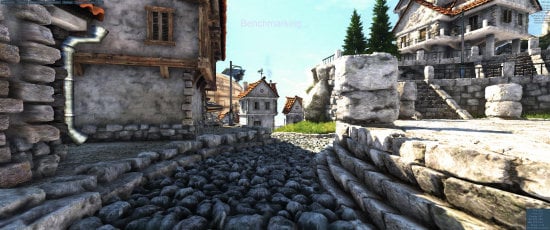
The Bottom Line
Introduction & Pricing
AMD released its new Radeon RX 5700 series graphics cards over a month ago now, offering up reference models of the Radeon RX 5700 XT and RX 5700 (my review on those here) with custom cards coming in a month later.
SAPPHIRE is the first out of the gate with a custom Navi graphics card in the Radeon RX 5700 XT PULSE OC, fueling Team Red fans with its first toe dipped into the custom RX 5700 series world. I'm hoping for a TOXIC variant from SAPPHIRE in a new custom RX 5700 XT, something that was teased in May 2019 as a custom watercooled Navi graphics card.
Until then, the new Radeon RX 5700 XT PULSE OC is the best we have from SAPPHIRE and a nice upgrade on the reference AMD Radeon RX 5700 XT in many ways. The custom cooler looks great, it runs cooler than the reference RX 5700 XT, has overclocking potential, and operates nice and quietly, too.
The world has been patiently waiting for custom Navi graphics cards, and we're off to a pretty exciting start with SAPPHIRE. If you were going to buy a Radeon RX 5700 XT and had to buy one today, then you would definitely want the PULSE OC on your radar.
Pricing
SAPPHIRE is charging just $10 more than the reference Radeon RX 5700 XT, so you'd be silly to not grab this versus the hotter, slightly slower reference model from AMD at $409.
Specs: Navi 10 GPU + 7nm Node + PCIe 4.0
Navi GPU Detailed
RDNA is at the heart of the new Navi GPU architecture, which delivers improvements at virtually all levels over the Polaris and Vega GPU architectures. The main component here is the 7nm process, mixed in with the use of GDDR6 memory (over HBM2 on Vega) as well as the huge step into PCIe 4.0 technology.
We can expect some big wins here with power and performance, with AMD tapping some of the knowledge it discovered with the Zen CPU architecture inside of Navi and RDNA.
This is the big difference between RDNA and the GCN (GraphicsCore Next) architectures, with AMD promising up to 50% performance gains -- breaking this up into around 60% performance-per-clock enhancements, 25% of it from the new 7nm node, and the rest in design frequency and power improvements.
AMD compares the new Navi 10 GPU directly against the Vega 10 used in the Radeon RX Vega 64 showing a 14% increase in performance, while using 23% less power. Vega 64 had a huge 495mm2 die while the new Navi 10 is on 7nm and using just 251mm2 in comparison. Overall, we're looking at a huge 2.3x increase in performance per area.
Don't worry, it isn't just going to be RDNA as RDNA is coming in 2020 on 7nm+.
PCI Express 4.0
AMD's new Ryzen 3000 series CPUs have been made with the new X570 chipset in mind, the first to market with PCIe 4.0 -- and the new Radeon RX 5700 series graphics cards are the first to market with PCIe 4.0 support. There is no gaming benefits right now, as PCIe 4.0 is more for storage and high-end tasks on GPUs that are bandwidth restrained. Gamers don't need to really care about PCIe 4.0, for now.
SAPPHIRE Dual-X Cooling
SAPPHIRE has had its Dual-X cooling technology on multiple cards, with the Radeon RX 500 series and Radeon RX Vega series cards both having Dual-X cooling models in the PULSE family.
The new SAPPHIRE Radeon RX 5700 XT PULSE OC uses the same Dual-X cooling technology as the previous PULSE cards, with two 92mm fans keeping the card nice and cool. The two fans have advanced airfoil section blades that better dissipate heat, with SAPPHIRE also using dust-repelling dual ball bearings for a longer-lasting card.
Detailed Look
Test System Specs
GPU Test Rig
Welcome to the latest revision of our GPU test bed, with our system being upgraded from the Intel Core i7-7700K to the Core i7-8700K. The CPU is cooled by the Corsair H115i PRO cooler, with the 8700K overclocked to 5GHz. We've stayed with GIGABYTE for our motherboard with their awesome Z370 AORUS Gaming 7.
We approached our friends at HyperX for a kit of their kick ass HyperX Predator DDR4-2933MHz RAM (HX429C15PB3AK4/32), with 2 x 8GB sticks for a total of 16GB DDR4-2933. The RAM stands out through every minute of our testing as it has beautiful RGB lights giving the system a slick look while benchmarking our lives away, while the Z370 AORUS Gaming 7 motherboard joins in with its own array of RGB lighting.
Detailed Tech Specs
- CPU: Intel Core i7-8700K @ 5GHz
- Cooler: Corsair Hydro Series H115i PRO
- MB: Z370 AORUS Gaming 7
- RAM: 16GB (2x8GB) HyperX Predator DDR4-2933
- SSD: 1TB OCZ RD400 NVMe M.2
- SSD: 512GB OCZ RD400 NVMe M.2
- PSU: InWin 1065W PSU
- Chassis: In Win X-Frame
- OS: Windows 10 Pro x64
Additional Images
Benchmarks - Synthetic
3DMark Fire Strike - 1080p
3DMark has been a staple benchmark for years now, all the way back to when The Matrix was released and Futuremark had bullet time inspired benchmarks. 3DMark is the perfect tool to see if your system - most important, your CPU and GPU - is performing as it should. You can search results for your GPU, to see if it falls in line with other systems based on similar hardware.
3DMark Fire Strike - 1440p
3DMark has been a staple benchmark for years now, all the way back to when The Matrix was released and Futuremark had bullet time inspired benchmarks. 3DMark is the perfect tool to see if your system - most important, your CPU and GPU - is performing as it should. You can search results for your GPU, to see if it falls in line with other systems based on similar hardware.
3DMark Fire Strike - 4K
3DMark has been a staple benchmark for years now, all the way back to when The Matrix was released and Futuremark had bullet time inspired benchmarks. 3DMark is the perfect tool to see if your system - most important, your CPU and GPU - is performing as it should. You can search results for your GPU, to see if it falls in line with other systems based on similar hardware.
3DMark TimeSpy
3DMark TimeSpy Extreme
Heaven - 1080p

Heaven is an intensive GPU benchmark that really pushes your silicon to its limits. It's another favorite of ours as it has some great scaling for multi-GPU testing, and it's great for getting your GPU to 100% for power and noise testing.
Heaven - 1440p
Heaven - 4K
Benchmarks - 1080p
1080p Benchmarks
Middle-earth: Shadow of War is a sequel to the popular Shadow of Mordor, which was powered by the Lithtech engine. When cranked up to maximum detail, it will chew through your GPU and its VRAM like it's nothing.
You can buy Middle-earth: Shadow of War at Amazon.
Metro Exodus is one of the hardest tests that our graphics cards have to go through, with 4A Games' latest creation being one of the best looking games on the market. It is a serious test that pushes GPUs to their limits, and also features RTX technologies like DLSS.
Far Cry New Dawn was developed by Ubisoft, and is powered the Dunia Engine, an engine that has been modified over the years for Far Cry and last used in Far Cry 5. Dunia Engine itself was a modified version of CRYENGINE, scaling incredibly well on all sorts of hardware.
Shadow of the Tomb Raider is one of the latest games to join our graphics card benchmark lineup, with the game built using the Foundation engine as a base, the same engine in Rise of the Tomb Raider. Eidos Montreal R&D department made lots of changes to the engine during the development of Shadow of the Tomb Raider to make it one of the best-looking games out right now.
Benchmarks - 1440p
1440p Benchmarks
Middle-earth: Shadow of War is a sequel to the popular Shadow of Mordor, which was powered by the Lithtech engine. When cranked up to maximum detail, it will chew through your GPU and its VRAM like it's nothing.
You can buy Middle-earth: Shadow of War at Amazon.
Metro Exodus is one of the hardest tests that our graphics cards have to go through, with 4A Games' latest creation being one of the best looking games on the market. It is a serious test that pushes GPUs to their limits, and also features RTX technologies like DLSS.
Far Cry New Dawn was developed by Ubisoft, and is powered the Dunia Engine, an engine that has been modified over the years for Far Cry and last used in Far Cry 5. Dunia Engine itself was a modified version of CRYENGINE, scaling incredibly well on all sorts of hardware.
Shadow of the Tomb Raider is one of the latest games to join our graphics card benchmark lineup, with the game built using the Foundation engine as a base, the same engine in Rise of the Tomb Raider. Eidos Montreal R&D department made lots of changes to the engine during the development of Shadow of the Tomb Raider to make it one of the best-looking games out right now.
Benchmarks - 4K
4K Benchmarks
Middle-earth: Shadow of War is a sequel to the popular Shadow of Mordor, which was powered by the Lithtech engine. When cranked up to maximum detail, it will chew through your GPU and its VRAM like it's nothing.
You can buy Middle-earth: Shadow of War at Amazon.
Metro Exodus is one of the hardest tests that our graphics cards have to go through, with 4A Games' latest creation being one of the best looking games on the market. It is a serious test that pushes GPUs to their limits, and also features RTX technologies like DLSS.
Far Cry New Dawn was developed by Ubisoft, and is powered the Dunia Engine, an engine that has been modified over the years for Far Cry and last used in Far Cry 5. Dunia Engine itself was a modified version of CRYENGINE, scaling incredibly well on all sorts of hardware.
Shadow of the Tomb Raider is one of the latest games to join our graphics card benchmark lineup, with the game built using the Foundation engine as a base, the same engine in Rise of the Tomb Raider. Eidos Montreal R&D department made lots of changes to the engine during the development of Shadow of the Tomb Raider to make it one of the best-looking games out right now.
Thermals & Power
Power Consumption
AMD already hits the 300W or so mark for our full Core i7-8700K system with the reference Radeon RX 5700 XT, while the overclocked SAPPHIRE RX 5700 XT PULSE OC uses a little more power with 315W total -- up from the 285W on the reference RX 5700 XT.
Temperature
SAPPHIRE's custom Radeon RX 5700 XT PULSE OC is leaps and bounds cooler than the reference RX 5700 XT, running at just 68C compared to the lofty heights of 84C.
Final Thoughts
SAPPHIRE nails its first custom Radeon RX 5700 XT graphics card with its PULSE OC with a great-looking card that performs better than the reference Radeon RX 5700 XT in more than one area.
Another trick up SAPPHIRE's sleeve is its TriXX Boost mode, which sees the card running at 90% of either 1440p or 4K which results in 2304x1296 and 3456x1944 respectively. This reduction in rendering resolution boosts gaming performance anywhere between 5-15% depending on the resolution and game.
The biggest point here with the RX 5700 XT PULSE OC is the custom cooling which keeps the card 16C cooler than the reference Radeon RX 5700 XT from AMD. In its stock form, the AMD Radeon RX 5700 XT is the hottest card we have in our GPU labs at 84C with the RX Vega 64 AIR close behind with 80C.
SAPPHIRE doesn't blind its Radeon RX 5700 XT PULSE OC up either, so we don't have something that will need you wearing sunglasses just to look at it. I really dig the red and black styling that SAPPHIRE went with:
SAPPHIRE has designed the backplate in such a way that it can dissipate heat much easier, but does so looking great as well. The ventilation definitely helps make it stand out from the reference card, which I would not buy over this starting today.
The only time you would've purchased a reference RX 5700 XT was if you simply couldn't wait and wanted Navi in your hands ASAP. If you did wait, then now is the time to pounce with a custom Navi card like the great SAPPHIRE Radeon RX 5700 XT PULSE OC.
More performance than the reference card, and close to 20C cooler operation is a no-brainer.

Performance (overclocking, power) |
95% |
Quality (build, design, cooling) |
95% |
General Features (display outputs, etc) |
90% |
Bundle, Packaging & Software |
90% |
Overall |
93% |
SAPPHIRE knocks it out of the park with the Radeon RX 5700 XT PULSE OC, coming in at a gigantic 16C+ cooler than the reference card... oh, and it's faster, and looks slick AF.

What's in Anthony's PC?
- CPU: Intel Core i5-12600K
- MOTHERBOARD: GIGABYTE Z690 AERO-G
- RAM: Corsair 32GB DDR4-3200
- GPU: NVIDIA GeForce RTX 4090 24GB
- SSD: Sabrent 4TB Rocket 4 Plus
- OS: Windows 11 Pro
- CASE: Lian Li O11 Dynamic XL
- PSU: ASUS ROG Strix 850W
- KEYBOARD: Logitech G915 Wireless
- MOUSE: Logitech G502X Wireless
- MONITOR: LG C3 48-inch OLED TV 4K 120Hz
Similar Content
Related Tags






















































